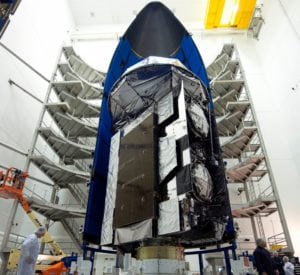Navy IDs Propulsion Failure as Cause of MUOS 5 Stall Out
[Via Satellite 08-03-2016] The United States Navy has traced the anomaly that caused the fifth Mobile User Objective System satellite (MUOS 5) to not reach its intended location to a failure of the orbit raising propulsion system. The satellite, which successfully launched on June 24, was projected to reach its geosynchronous orbit and enter its test location 22,000 miles above Hawaii by July 3. The anomaly occurred during a transfer maneuver on June 29 that was designed to take the satellite from its initial elliptical launch orbit to its final circular geosynchronous orbit, resulting in a halting of the maneuver.
The Navy reports that MUOS 5 is currently stable, safe and under positive control. The satellite remains in a stable intermediate orbit since experiencing the anomaly. MUOS team members are continuing to evaluate the situation, considering alternate orbit adjustment options, calculating mission impact and investigating all options before proceeding.
Built by Lockheed Martin, MUOS 5 is an on-orbit spare intended to provide immediate redundancy to the MUOS constellation. MUOS 1 through MUOS 4 are in orbit and are currently supporting operations via their legacy payloads, providing Ultra-High Frequency (UHF) satellite communications for the U.S. Department of Defense (DOD). According to the Navy, the delay in MUOS 5 reaching its test location has no impact upon current legacy or upcoming Wideband Code Division Multiple Access (WCDMA) satellite communications operations.
